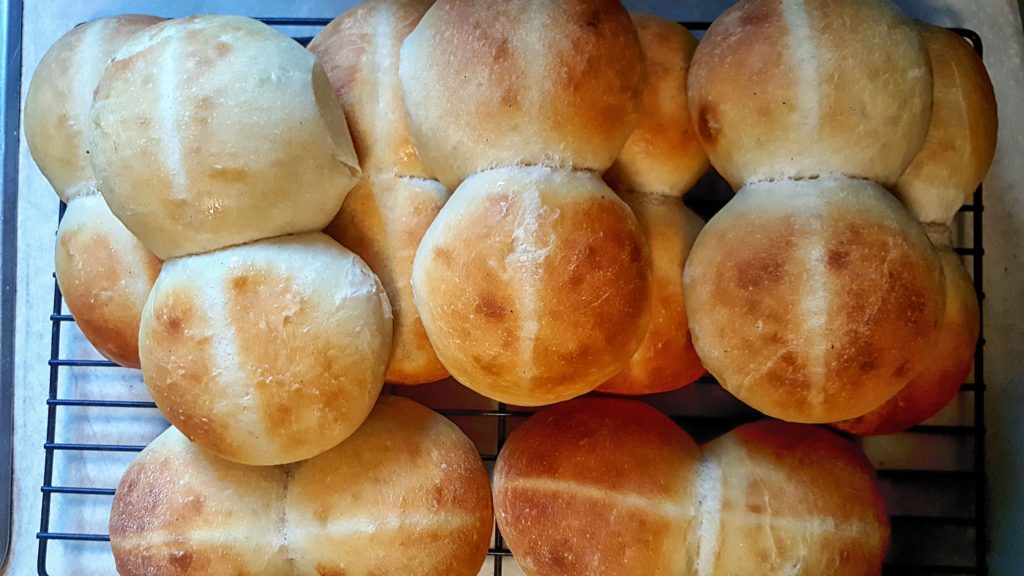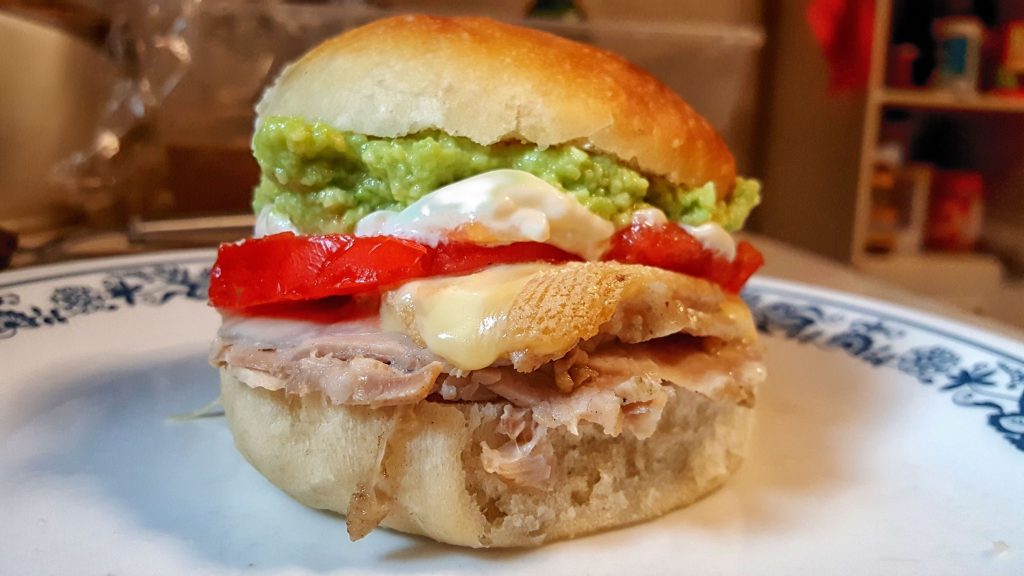Lomito Italiano
Welcome back to one of my favorite subjects, Chilean sandwiches. South America is a sandwich wonderland, and nowhere are they revered so much as in the long narrow mountains-and-ocean corridor that is Chile. This month we’re covering Italiano, which isn’t an actual sandwich but rather a combination of condiments–avocado, mayonnaise, and tomato, green white and red to represent the colors of the Italian flag–and is used to enhance all kind of sandwiches in Chile, even hot dogs!
With many options to choose from–but many of them having already been covered by the Tribunal–I elected to choose one of Chile’s most popular sandwiches, yet one that strangely has not made it onto the Wikipedia list from which we derive our own List–the Lomito.
In Chile, Lomito is a braised pork loin, sliced thin and piled high on one of Chile’s sandwich breads—pan amasado, pan hallula, pan frica, or the strangely shaped but interesting pan marraqueta. I’ve made pan amasado before, a flat rich sandwich roll, but I’m told that marraqueta is the best bread for many Chilean sandwiches, and I felt I’d better give it a shot this once.
Pan Marraqueta is also called pan frances, or French Bread, and it’s essentially an odd arrangement of linked demibaguettes. I hadn’t tried baking my own bread for the site in a while–I tend to do more baking during the winter, as otherwise my kitchen can get unbearable–and shaping the loaves or rolls has never been my strong point, but why not? The worst that can happen is that a Chilean journalist tells me I’m wrong again.
This recipe tells me that, rather than 4 linked long rolls, marraqueta is shaped as 2 round linked rolls and then smashed down in the middle to split the whole lengthwise.
A note on my experience using bread recipes: I think that flour must absorb water differently in my house than in other places. Scientifically, that does not make much sense, but the fact remains that my doughs seem to be much stiffer than the recipe authors describe, when using the same measurements they do. In this case, the measurements are 8 cups of bread flour (I know, I’d get better results using weight or mass than volume) and 2.5 cups of water. This was supposed to result in a semi-soft dough. I couldn’t even get the dough to come together fully. I had to add more water a bit at a time until it did, and even then it broke my dough hook.
After I finished kneading the dough by hand (and ordered another dough hook on Amazon), I let the dough rise refrigerated overnight rather than the scant half-hour suggested by the recipe, to give it some more flavor. Then I separated it into the 3.5oz rolls suggested, rolled them into ovals, dabbed them with a bit of water and set them end-to-end and let them stick together a bit before using the back of a knife to split them lengthwise. After allowing them to proof, I baked them in a hot, steamy oven for 18 minutes. The results were mixed.
The dough sprang back and wasn’t as clearly separated into 4 sections as they were supposed to be, and the bread, while tasty, was a bit denser and chewier than you’d want for a sandwich. They made terrific dinner rolls when reheated in the oven the next day.
For the lomito, I brined a 4lb pork loin overnight in a simple brine of 1 gallon water, 1 cup of salt, 2 Tbsp of pickling spice, 4 cloves of garlic and 1 chopped up onion. After rinsing the brined loin and patting it dry, I browned it on all sides in a Dutch oven, then added 1 can of beer, another chopped-up onion along with carrot, celery, and garlic, some white pepper and dill, and enough water to almost cover the loin. It cooked in a 300 degree oven for about 1:45 until fully cooked (probably just a bit too cooked, but we’ll be slicing it thinly) before I transferred it to a container, poured over about half the braising liquid, covered it and chilled for several hours.
In the meantime, I made some palta, or Chilean avocado mash. They generally just add a little salt and olive oil, but I like a bit of acidity so I supplemented with just a bit of fresh lemon juice. I also sliced up some tomatoes. Normally I’d make homemade mayonnaise for this, but the commercial type is far whiter than homemade and would photograph better so I stuck with it. Then I hand-sliced the pork for the sandwiches.
- Chilean avocado mash or “palta”
- Sliced tomatoes
- sliced braised pork loin, or Lomito
Generally speaking, a Chilean making a sandwich will break off 1/2 or 1/4 of a marraqueta to use for a sandwich, as the whole thing would be just too damn big, especially given the generous nature of Chilean sandwiches. So I used half of a roll for each sandwich.
To assemble, I reheated 4 or so slices of pork in some of the braising liquid and placed on the lower half of the marraqueta roll. On the upper half, I first spread the palta, then some mayonnaise, and finally added a layer of salted tomatoes.
And the final result?
The name Italiano may seem gimmicky, but I have to imagine the combination came about before the name did. Tomatoes bring a juicy, savory, and fresh flavor to a sandwich; mayonnaise is the perfect dressing for them; and fresh mashed avocado adds a richness all its own. It’s sloppy–really sloppy–but Chileans eat their sandwiches with a knife and fork, generally, and there are plenty of sandwiches meant to be eaten with the hands that are equally messy, if not more so. I’m looking at you, Italian beef. (Longingly, of course)
It makes sense that this has its own entry on the List, as the combination itself could enrich any sandwich, whether a lomito sandwich like this, a churrasco sandwich, or even, as we saw earlier, the lowly hot dog. To be honest, it would probably make a great sandwich all by itself. Tomato sandwiches are a thing. Avocado sandwiches are a thing. Heck, even mayonnaise sandwiches are a thing (just not a very good thing). If you put all three together, why wouldn’t it be great? Add in some delicious braised pork or thin-sliced steak or a tasty sausage (or heck, how about some bacon?) and that tasty snack just became a serious sandwich.

I like sandwiches.
I like a lot of other things too but sandwiches are pretty great














This does make scientific sense, btw. The amount of humidity in the air makes a large difference to how flour reacts to water. This means that baking recipes in a humid place and a dry place can be quite different. This happens whether you measure by weight or by volume (but please do measure by weight). I presume you’re already compensating for the fact that US cups are a little different in size to metric cups.
I ate a lot of Chilean sandwiches on marraqueta on a recent trip there. I think the flour they use is different from our bread flour. Maybe it’s softer or harder than what we use, or has more or less gluten. The marraqueta were soft, but held up well and didn’t taste very yeasty to me. I really liked their pan integrale: a soft whole wheat loaf baked in a pullman loaf pan and sliced very thinly. It is usually eaten at breakfast time.
My son and his Chilean girlfriend will be visiting from Santiago next week and we intend to eat a lot of sandwiches here in Oregon.